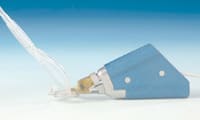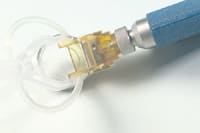spotlight
on technology & technique
Raising the Bar for Disposables
A new, fully automated single-use microkeratome produces first-class outcomes.
By Christopher Kent, Senior Associate Editor
|
|
|
|
The One Use-Plus automated
disposable microkeratome
from Moria. |
|
In the ongoing struggle to provide better surgical outcomes -- and do so efficiently and safely -- disposable instruments have become an increasingly popular option. The benefits of using a new instrument for each procedure or patient are multiple: no time-consuming sterilization and maintenance, no worries about improperly cleaned or sterilized instruments, minimal handling, no repair costs should damage occur, rapid patient turnover and minimal initial capital outlay. In addition, a new blade for every patient often produces better outcomes. (For an example of clinical data on this subject, see "The Draw of Disposables" in the April 2004 issue of Ophthalmology Management.) For all of these reasons, many LASIK surgeons are now opting to use disposable microkeratomes.
The One Use disposable keratome from Moria has been popular since 2001. Recently, however, Moria has taken this technology one step further by creating an automated version -- the One Use-Plus -- that adds significant advantages to the original.
No Shortage of Features
The One Use-Plus is a fully-automated, nasal hinge microkeratome, sold in sterile packs that include a suction ring, vacuum tubing and head. Each unit has two separate motors, one for advancement and one for blade oscillation; a high oscillation rate maximizes the smoothness of the keratectomy and creates a comfortable edge margin. The consistent translation speed resulting from automation increases precision and produces smoother flaps and beds.
Because of its design, the One Use-Plus is easy to use, with a short learning curve and rapid setup (the unit is preassembled). Other advantages include:
► Unlike early disposables, the One Use-Plus gives you plenty of flexibility. Flap thickness, diameter and hinge size are variable, and the unit provides two translation speeds. Multiple suction rings accommodate different sized corneas, regardless of K value.
► The dual-port suction ring generates homogenous suction.
► The translucent ring and head allow blade inspection before surgery and visualization of the flap during the procedure. They also make it easy to verify suction -- you can see the instrument grab hold of the cornea.
► Because the footprint of the One Use-Plus is small, it can be used on many eyes with too narrow a palpebral fissue to allow the use of other microkeratomes. In fact, in some cases when the orbit is especially small, the vacuum ring can be used to hold back the lid without the use of a speculum.
► The control unit monitors pressure continuously and contains a built-in rechargeable power battery to maintain consistent power under any circumstances.
► The instrument is suitable for one-handed use.
According to Moria, the One Use-Plus surpasses the performance of its manual microkeratomes. High-precision cast molding ensures consistent, predictable clinical results and robustness equal to a reusable system, and every set is quality-control inspected.
Feedback From the Field
Mark Swanson, M.D., who practices in Douglas, Ariz., and at the Swann Oftalmologia y Laser Intituto in Mexico, conducted one of the first studies using the One Use-Plus. (For more about the study, see "The One Use-Plus: A Clinical Evaluation" on the facing page.) Dr. Swanson has no financial interest in Moria or the One Use-Plus.
"At the outset," he says, "I was concerned about a number of things regarding the use of a disposable instrument. For example, I expected the One Use-Plus to produce more friction than a conventional microkeratome. In fact, I've found that it produces less friction. I haven't seen any abrasions on the epithelium using this system, and it seems to cause less inflammation. The interface is very clear, very clean, very smooth."
Dr. Swanson calls the outcomes he's been achieving "perfect." "Most patients are 20/20 or 20/25 by the next day; often on the same day. I no longer use conventional blades to make LASIK flaps at all."
Dr. Swanson believes that an automated disposable keratome is preferable to a manual disposable. "The automated keratome produces consistent translation speed, resulting in a uniform flap and smooth stromal bed. It's more predictable. Also, the flap is made very fast. It takes less than a second to get everything done. I only use suction for 3 to 5 seconds."
Dr. Swanson also saves time by using Moria's disposable LASIK kit, which includes a disposable speculum, scraper and marker. "We don't have to sterilize anything," he points out. "All of this improves our turnaround time. We can do each case in about 10 minutes, and we don't have a long waiting time between patients."
Concerns Unwarranted
Dr. Swanson notes several other advantages of the One Use-Plus. "It requires minimal handling," he says. "The handpiece itself is very light and very small, and attaching the head to the handpiece is quick and easy. I just hold the suction ring handle in position and it makes a perfect flap -- I don't have to hold the handpiece.
"In terms of cost-effectiveness, it works out about the same as the reusable unit. The cost is offset by our savings in technician time, faster turnaround and seeing more patients.
"Also, the control unit can be used with other Moria keratomes, such as the LSK One and CB for ALTK and lamellar procedures, and the M2. It will also work for a new automated, disposable epithelial separation unit that's currently in development."
Dr. Swanson adds that he never expected to end up switching to the One Use-Plus for all his LASIK cases, but he now believes that it's better for the patient and produces better outcomes. "All of my concerns turned out to be unwarranted, and the advantages of the One Use-Plus have won me over," he says. "I would definitely recommend it to other surgeons."
For More Information
To find out more about the One Use-Plus, call (215) 230-7662 or visit www.moria-surgical.com on the Web.
|
The One Use-Plus: A Clinical Evaluation |
Mark A Swanson, M.D., recently conducted a clinical evaluation of the Moria One Use-Plus. He evaluated 52 eyes of 26 patients, ranging from age 18 to 57, who were undergoing bilateral LASIK. Among the myopic patients, preoperative sphere averaged -3.2D with cylinder ranging from 0 to -5.5D; among hyperopic patients sphere averaged 2.36D, with cylinder ranging from -0.5 to -3.5D. Dr. Swanson used the 130-micron head (one per patient, not per eye), with the -1 suction ring and the 7.5-mm stop in all but two eyes. The data showed:
|










